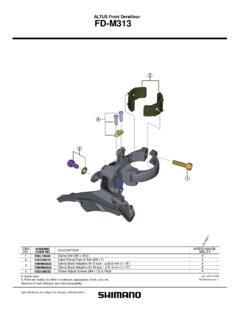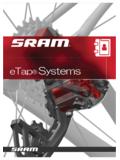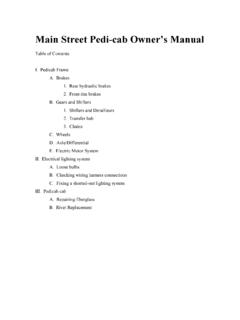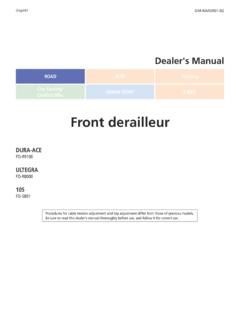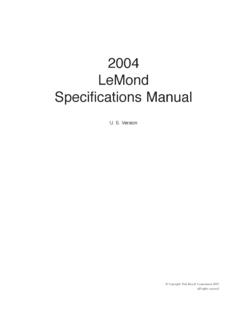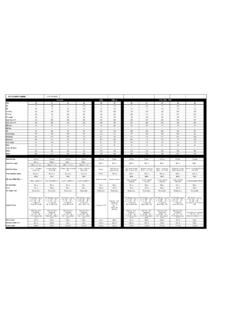Transcription of HUMAN POWER - IHPVA
1 NUMBER 50, SPRING 2000 Summaries of articles in this issue; mast .. 2 Contributions to HUMAN POWER .. 2 ArticlesOn the efficiency of bicycle chain drives James B. Spicer and others.. 3 Offset rims reduce the amount of dish Vernon Forbes .. 10 Rolling resistance of bicycle tyres John Lafford .. 14 Note on John Lafford s paper and spreadsheet Jim Papadopoulos .. 15 Reply to Jim Papadopoulos John Lafford .. 18 Technical notesPower requirements for laid-back recumbentsBert Hoge and Jeroen Schasfoort in HPV nieuwsReport and comment by Dave Wilson.. 18My propeller theoryE. Eugene Larrabee .. 20 ReviewsFeet on!: pedal-powered museum exhibit Michael Eliasohn.
2 21 HUMAN POWER : the forgotten energy Arnfried Schmitz, reviewed by Dave Wilson.. 22 EditorialCycle Vision, Ronald van Waveren.. 23 LettersUpdate, Anil Rajvanshi.. 14 Supplement to velocar variations, Arnfried Schmitz.. 22 Kudos, Chet Kyle.. 23 Number 50 Spring 2000$ JOURNAL OF THE IHPVAHUMANPOWER tions (Juden 1997). Without detailedanalysis of Keller s results, it appearsthat they do not wholly support the ideathat the efficiency is governed by fric-tion. Work by Kidd, Loch and Reuben(1998) has attempted to quantify driveefficiency in relation to models of drive-train performance based on chain con-tact forces. While static measurementsof these forces have agreed with mod-els, efficiency-measurement resultshave not appeared in the literature(Kidd et al.)
3 1996). In this work, the efficiencies of bicy-cle chain drives are investigated bothexperimentally and theoretically to iso-late factors associated with loss inthese systems. A computer-controlleddrive-train-testing system was designedto measure the performance of thechain, chain ring and rear cassette in aderailleur-type system. This system wasused to measure chain-drive perfor-mance under a variety of operatingconditions. Assuming that frictionalforces degrade the overall efficiency ofHuman PowerNumber 50, Spring 20003 ABSTRACTThe efficiencies of bicycle drivetrains have been studied to understandenergy-loss mechanisms in these sys-tems. An analytical study of frictionalenergy loss along with a series ofexperimental efficiency measurementsof derailleur-type chain-drive systemsunder a range of POWER , speed andlubrication conditions are given toidentify loss mechanisms.
4 These mea-surements of mechanical efficiency arecompared to infrared measurementsperformed during drive operation thatshow the heating of drive componentsresulting from frictional losses. Theresults of this study indicate that chaintension and sprocket size primarilydetermine chain-drive efficiency. INTRODUCTIONWhen this study was performed, itwas hoped that through identificationof the loss mechanisms primarilyresponsible for limiting the efficiencyof bicycle chain drives, methods forimproving efficiency could be realizedby eliminating or decreasing the vari-ous losses. Unfortunately, as will beshown, definitive identification of thesemechanisms has not been , the results provide informationon the efficiency of chain drives and, atthe same time, lead to conclusionseliminating those mechanisms that donot dominate efficiency.
5 We hope thatthe results here contribute to the over-all body of work on chain-drive effi-ciency and also to the on-going discus-sion of this topic (Cameron 1999; Wil-son 1999).Even though design of chain drives isfairly well-understood (Vogwell 1994)the factors affecting efficiency havebeen considered only in passing as partof the design process. Generally designfactors that are considered includechain length, load ratings, roller impactvelocity, rotational forces, contactforces, chordal action and chain vibra-tion (Tordion 1996). Since some of theseare dynamic effects, the work presentedhere was conducted on chain drivesduring and Hills (1986a) per-formed a detailed theoretical andexperimental study of chain contactforces during link articulation in heavy-duty chain drives and used theseresults to calculate the theoretical effi-ciency of chain drives assuming thatfrictional losses primarily affected effi-ciency (Hollingworth and Hills, 1986b).
6 They found that the efficiency of thechain drive should increase with thenumber of sprocket teeth on each ofthe driver and driven sprockets. Unfor-tunately, no experimental results weregiven to verify their models. In the work by Keller (1983) measure-ments of efficiency were made for dif-ferent transmission systems (derailleur,internally geared hub, fixed), usingchains exhibiting various conditions ofrepair (new, used, non-lubricated),under a variety of POWER -transfer condi-On the efficiency of bicycle chain drivesJames B. Spicer,* Christopher Richardson, Michael J. Ehrlich and Johanna R. BernsteinThe Johns Hopkins University, Baltimore, Maryland 21218 Masahiko Fukuda and Masao TeradaShimano Inc.
7 , Product Engineering Division, Sakai Osaka 590-77 Fig. 1. Experimental schematic of test stand showing elements of the driveassembly2 Number 50, Spring 2000 HUMAN PowerHUMAN POWERHUMAN POWERis the technical journal of theInternational HUMAN Powered VehicleAssociationNumber 50, Spring 2000 EditorDavid Gordon Wilson21 Winthrop StreetWinchester, MA 01890-2851 editorsToshio Kataoka, Japan1-7-2-818 Hiranomiya-MachiHirano-ku, Osaka-shi, Japan 547-0046 HQI04553@niftyser Schmidt, EuropeOrtb hlweg 44CH-3612 Steffisburg, Thiel, Watercraft4720 - 7th Avenue, NESeattle, WA 98105 USAP roductionJS Design & JW StephensIHPVAPaul MacCready, Honorar y presidentChris Broome, USA, ChairBen Wichers Schreuer.
8 The Netherlands,Vice-chair,Open, Secretar y/treasurerPublisherIHPVAPO Box 1307 San Luis Obispo, CA 93406-1307 USAP hone: +805-545-9003; POWER (ISSN 0898-6908) is pub-lished irregularly for the InternationalHuman Powered Vehicle Association, anon-profit organization dedicated to pro-moting improvement, innovation and cre-ativity in the use of HUMAN POWER gener-ally, and especially in the design anddevelopment of HUMAN -powered vehicles. Material in HUMAN POWER is copyrightedby the IHPVA . Unless copyrighted also bythe author(s), complete articles or repre-sentative excerpts may be published else-where if full credit is given prominently tothe author(s) and the IHPVA .
9 Individualsubscriptions and individual issues areavailable to non- IHPVA and non-HPVA members. Number 50 Spring 2000$ members, $ THIS ISSUEB icycle chain transmissionsJim Spicer and his associates at JohnsHopkins have written a paper that willchange minds, and design directions, onHPV transmissions. To give just oneexample: the losses associated with smallsprockets on the rear wheel make mid-drives or countershaft gears suddenlyattractive, and possibly hub gears also find that chain lubricationdoesn t seem to reduce losses: that will beeven more controversial. (Your editor hashigh confidence in the data: he asked ChetKyle, IHPVA founder and one of theforemost researchers in bicycle perfor-mance in the world, to look at them beforepublication.)
10 He had done a proprietarystudy on the same topic, and has producedbroadly similar results.) Offset rimsVernon Forbes gives us another of hiscareful studies of spoked-wheel construc-tion incorporating derailleur clusters orbrake disks that cause the wheel to be dished (spoked asymmetrically). Heshows that the use of rims that have off-center spoke holes brings about a consid-erable reduction in the difference in spoketensions that otherwise makes highlydished wheels prone to spoke failure andoccasionally to resistanceJohn Lafford has tested, on equipmentof his own design and construction, aprodigious number of bicycle tires, mostlyof a size particularly suited to the frontwheels of recumbent bikes.
